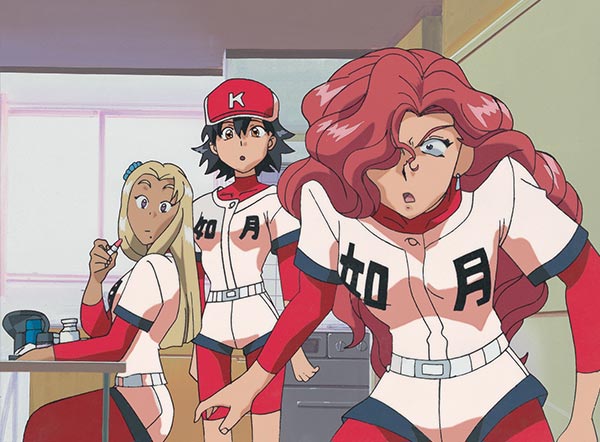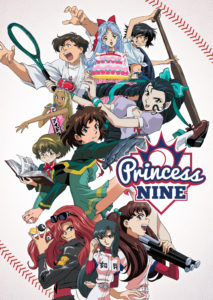This show should have sucked, but it kicks a**
With its late-90s animation and bleeding-heart hollow feminism (let’s see if these girls can do what the BOYS can do!), there should be no reason why 1998’s Princess Nine could stand up amongst today’s sports anime. The opening episode confirms this. The dialogue: canned. The storyline: predictable. The animation: extra-gooey nacho cheesy. This show should have sucked.
But it doesn’t. It kicks a**.

The story begins with our hero Hayakawa Ryo striking out the side in the final inning of an amateur adult-league game. Watching Ryo closely, Himuro Keiko, the posh president of the Kisaragi Girls School, recruits her to join the school’s first baseball team with the goal of reaching the Koushien national high school baseball tournament. Himuro’s genius tennis-playing daughter, Izumi, develops a competitive rivalry with Ryo at Kisaragi that spills into a romantic struggle over Kisaragi Boy’s star first baseman, Takasugi Hiroki. Amongst this typical anime storyline falls an even more typical backdrop of girl-power, high school drama, romance, friendship, and shonen kicks, all with a magical seasoning.
Magical girls and baseball? And aliens?

Magical girls series became en vogue in the late 1990s off the heels of Sailor Moon, and it was only a matter of time before Japan gave girl-power the baseball treatment. But Princess Nine is more of an action show than a baseball show, with its characters modeling archetypes straight from American superhero mythology. The former track star-turned-pool shark Seira fights herself out of an alley with billiard balls with the help of her drunken and lecherous head coach and agrees to play second base after the coach squeezes her out of trouble. The centerfielder Hotta models her swing after the ocean waves as the daughter of a traditional fishing family, and her introduction comes with all the drama and violence of a beachside thunderstorm. Even the meekest character Yuki empowers herself through a bond with a plush alien named Fifi from the planet Yukara. It’s pretty weird for a baseball show.
Thankfully, the show displays a remarkable self-awareness for how ridiculous it is. To secure a practice game against a veteran tournament team that refuses to play against girls, Himuro makes up a story about how the boy’s team fears batting against Ryo’s “magic ball.” The story, of course, is fake. Except Ryo eventually develops an unhittable “lightning ball,” with an absurd recycled animation to match, that surpasses any magic expected between the lines of a baseball field. And somehow, it works.
Whenever a convenient plot point appears, the team’s manager/cheerleader Nori Meme reminds the audience of when she saw the same thing happen in a baseball manga. Though the series steals a lot from its predecessors, Meme’s less-than-subtle nods affirm the show’s thievery as more of a tribute than larceny. And when Izumi does absurdly athletic things like hit a fastball coming for her head like an overhand tennis serve or somersault over the catcher for a game-tying run, the reactions include more pumped fists than hearty groans. This is a superhero show, after all.
Not Just Eye Candy Girls
But despite the girls’ supernatural abilities, Princess Nine treats its characters like emotionally complex people instead of the eye candy for chauvinists like they often become in sports anime. The character designs go beyond the same-body-different-hair theme we often see from girl characters. The girls show a nice mix of feminine characteristics (the aspiring model Yoko, the flirty Yoshimoto), masculine features (the judo star Mao, the badass Seira), and those to whom labels don’t apply (Ryo, Izumi). Even the half-baked romantic subplot fails not because Ryo and Izumi’s love doesn’t feel genuine, but because their heartthrob Hiroki feels so vanilla in comparison to the three-dimensional main characters. In this show, it’s the boys who don’t have any personality.
Maybe Princess Nine could’ve introduced some queerness that often pervades girls sports circles, though that would be a tough ask today, much less in 1998. It could’ve also done away with its two heavy arcs, not only because they didn’t add any emotional resonance to the series, but also because topics like suicide and dying children require a careful and comprehensive approach. But much like the Kisaragi Girl’s team, Princess Nine is never dull, and at its best, it competes with the greats.





